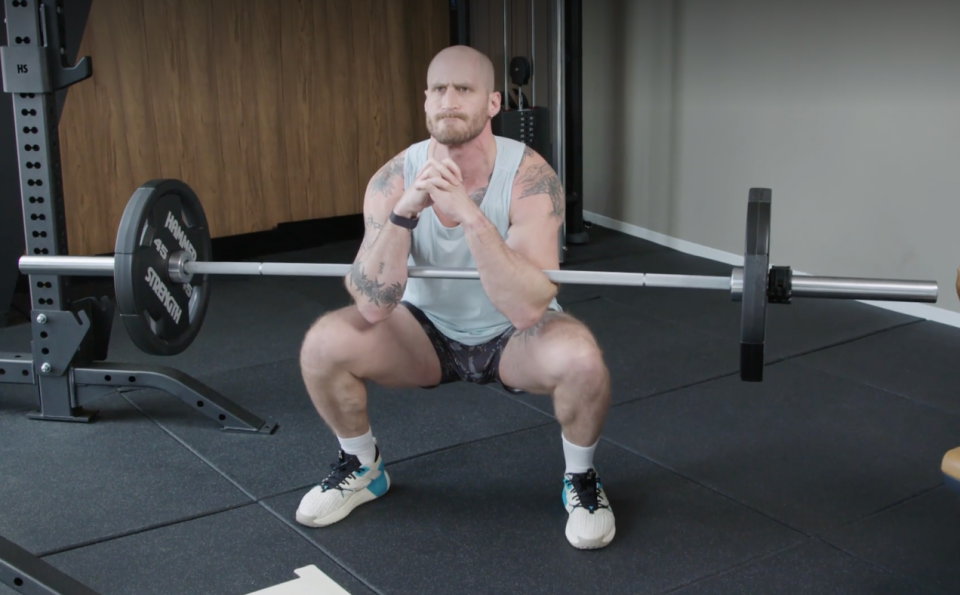Level Up Your Leg Day Workout With the Zercher Squat
WHILE THERE ARE loads of squat variations you can pick for your leg day workouts, few challenge the muscles of your core and back the way the Zercher squat does.
The difference is all in the positioning of the load. Classic barbell back and front squats require strength and stability of your abdominal and back muscles to properly support the spine through the movement. The Zercher squat utilizes a unique hold, where the barbell sits in the crux of your elbows. That placement forces you to fight against weight of the barbell to prevent it from pulling the torso forward, lighting up the core and back muscles.
"The idea of the Zercher is something we can apply to all our lower body lifts," says Ebenezer Samuel, C.S.C.S., MH fitness director. "It's essentially a way to grasp the weight in a way that is going to challenge our torso and upper body differently."
Here, Samuel lays out everything there is to know about the Zercher squat, including how to do it correctly, whether its a lift that's right for you, and how to incorporate it into your routine.
How to Do the Zercher Squat
Set the rack at about waist height. Squat down to get the barbell into the crux of your elbows. Make sure your upper arms perpendicular to the ground, and squeeze your elbows close together.
Roll the shoulder blades down and back to create that mid-back tension. Make fists with your palms facing each other, or clasp your hands together to create tension throughout your arms.
Stand up from the rack, and step back. Find your ideal squat stance so that you're able to open up your knees wider than shoulder width as you come down, creating space for your elbows.
Just like your standard squat, keep your weight even between your toes and heels. Squeeze your shoulder blades, abs, and glutes, and take a deep breath. Hold that breath as you push your butt back then bend at the knee and lower down keep your torso upright. Hold that bottom position for a second or two, but don't rest your elbows on your knees.
Squeeze your glutes to return to standing.

How to Use the Zercher Squat in Your Workouts
There are two ways to effectively use the Zercher squat: Use this on your leg days as one of your top two lifts, Samuel says. Train it heavy with, lower rep ranges. Aim for about 3 to 5 sets of 3 to 5 reps.
You can also slot in the Zercher squat and one of the last movements of your leg day routine, with lighter weight and higher reps to really burn out the quads and glutes. Make it your third or fourth exercise. Aim for 3 to 4 sets of 12 to 15 reps.
Which Muscles Are Used in a Zercher Squat?
Like any squat, the Zercher is going to hammer your quads, glutes, and hamstrings. The unique thing about this variation is the location of the load will require a bit more output from your core and midback muscles.
"The load is a lot closer to our abs and a lot closer to our midline, so it's going to challenge us in a different way from a stability standpoint," forcing you to learn how to brace your abdominal muscles, Samuel says. That stability also requires output from your mid-back muscles like your rhomboids, upper spinal extensors, and rotator cuff muscles.
One misconception about the Zercher is that it can be considered a biceps exercise. While the load is being held in the elbows and the biceps are contracted, they're not moving through any range of motion and are not placed in a challenging lever. Stick your standard biceps curls if you're looking to work those muscles.
Should I Add Zercher Squats to My Workouts?
The Zercher squat may be worth adding to your routine if you fall under one of three categories.
You Struggle with Squat Form
The nature of the Zercher hold is going to force you to learn proper bracing, which is easy to neglect during traditional front and back squats. If you're the kind of person that struggles to remember to fire up your core through your leg sets, the Zercher is a great way to learn, and will benefit all your other leg day lifts.
You're Training for Strongman
Strongman competitions are filled with heavy lifts that require you to pick up heavy loads in front of you, mimicking the Zercher position. "If you're a Strongman, this [lift] is mandatory, and you probably know that already," Samuel says.
You Want to Shake Up Your Workouts
You've been doing tons of front squats, goblet squats, and back squats, and you're bored. We get it. The Zercher is a great way to mix up your routine.
Misconceptions About the Zercher Squat
You'll see the Zercher being advertised as a "functional" movement all throughout TikTok and Instagram. Many of these posts compare the exercise to the movement of picking up a person. These posts make you think that this variation is needed for carrying loads out in front of you.
That's not right. Samuel says, that as long as you're doing other squats, deadlifts, and rows, then you've covered all the muscle groups required to perform this act. So, it's not as vital (in that way) as social media may say it is.
You Might Also Like

